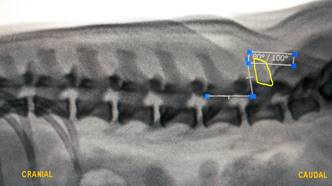ABSTRACT:
The aim of the study was to assess hemodynamic changes and complications of spinal anesthesia with ropivacaine at different baricities. Six beagle dogs aged four years. The dogs were anesthetized with isoflurane and subjected to the following treatments: Ghypo = spinal anesthesia with hypobaric ropivacaine (0.5mL of 0.9% NaCl+0.5mL ropivacaine at 0.75%); Giso = isobaric spinal anesthesia (0.5mL of 0,906% NaCl+0.5mL ropivacaine at 0.75%); Ghyper = hyperbaric spinal anesthesia (0.5mL of 10% glucose+0.5mL ropivacaine at 0.75%). After induction to anesthesia and maintenance with isoflurane, animals were positioned in right lateral recumbency for pulmonary artery catheterization through the left jugular vein. Spinal anesthesia was carried out with injection of 1mL of local anesthetic using a 22G Quincke tip needle in the L5-L6 space along 1 minute. Dogs were maintained under inhalation anesthesia for 60 minutes in ventral recumbency. HR, FR, MAP, CO, mPAP and body temperature progressively increased in all groups, whereas PCWP increased only in GHYPO at all time points. The TPRI showed significantly higher values in GISO at M1, M5 and M10 compared to the other groups, except for M5, during which GISO differed only from GHYPER. The PVRI increased at M5 compared to MB in GISO. Side effects such as unilateral motor deficit, bladder atony, excitation, acute pain and chemosis were observed. The hemodynamic changes were not relevant, although inhalation anesthesia with isoflurane might have influenced the results. The changes observed in the study demonstrate that motor blockade is likely to be obtained with isobaric and hyperbaric ropivacaine, thereby confirming the influence of baricity on the type of nerve fibers on the spinal cord. The isobaric solution results in a mixed blockade (motor and sensory blockade). Hemodynamic changes such as hypotension and bradycardia were not evidenced in this study, although local anesthetics were administered in low volumes and together with isoflurane anesthesia. Regarding complications, post-anesthetic observation is warranted in order to identify and treat possible changes. Spinal anesthesia in the conditions studied did not cause hemodynamic changes in isoflurane-anesthetized dogs and is thus considered safe for routine practice, although a few complications are prone to occur.
INDEX TERMS:
Regional anaesthesia; spinal cord; subarachnoid; cardiovascular; complications; canine.

 Thumbnail
Thumbnail
 Thumbnail
Thumbnail

